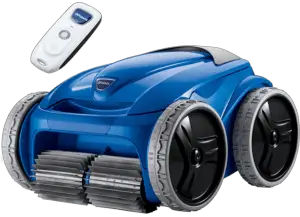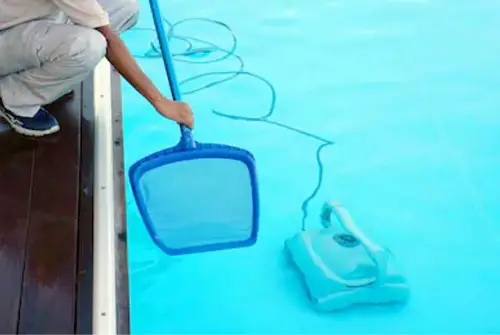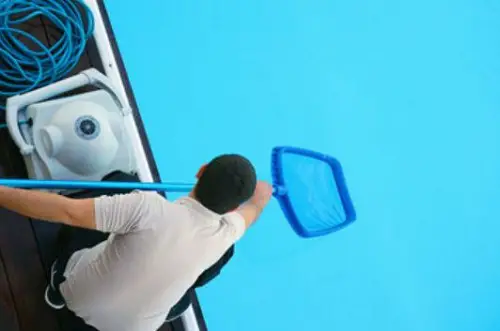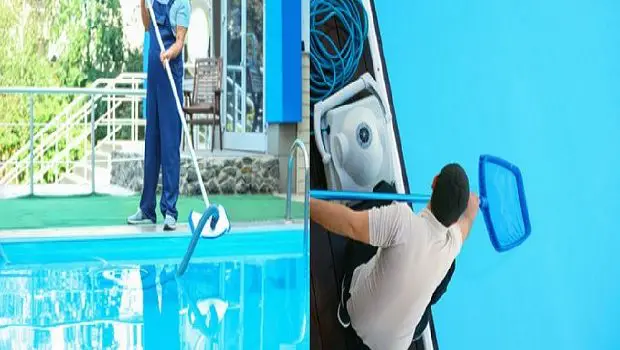Polaris Pool Cleaner Troubleshooting: Top 10 Problems Solved
DISCLOSURE: As an Amazon Associate, I earn from qualifying purchases.
Investing in an efficient pool cleaner is always the right decision. It can save you a lot of time that you spend skimming and vacuuming your pool. If you’ve ever let a robotic vacuum-free in your house, you know how awesome it can be to have a small device doing the hard work for you while you anything else.
One of the popular brands in automated pool cleaners is Polaris and for a good reason. They are reliable, operate correctly, and face it; they’re cute small underwater robots. Though like any automated device, they seldom malfunction. Before you just throw it and go back to manual cleaning, try your hand at Polaris pool cleaner troubleshooting. Knowing the problem is half the struggle.
Polaris Pool Cleaner Troubleshooting Tips

Lots of problems can occur with a pool cleaner, such as damage from animals, falling tree limbs, and even the sun. These are considerably more likely if you leave your Polaris cleaner outdoors in the open rather than keeping it in a garage or shed.
We’ll hope you’re keeping your pool cleaner away when not in use and concentrate on issues that can crop up while it’s in operating mode.
Your Pool Cleaner Pauses
A common difficulty with automatic pool cleaner is that they just stop moving. There it is, vacuuming the bottom of your swimming pool when it abruptly just stops. You wait for a few minutes to know if it’ll restart on its own, but no, it remains there, waiting to be rescued.
Few problems may cause this stalling out.
Broken Booster Pump
If you’re not getting intense pressure from the return line you attach to the automated pool cleaner, it might be that the filter, pump, or the cleaner’s booster pump is failed to function.
Check your filter and pump first. If they’re working well, you’ve narrowed it down to the booster pump. While it might be repaired, the time and cost of fixing it will most likely add up to higher than the price of replacing it.
Clogged or Broken Quick Disconnect
Your Polaris Pool cleaner’s hose is connected to the return jet with a little piece known as a quick disconnect. Inside this piece, a screen is there to catch debris coming from your filter so that it doesn’t enter into the pool cleaner. If that screen gets clogged, your pool cleaner will protest by freezing in place.
Check the screen to be sure it’s free and clear of any debris or sand. If it’s clogged, remove it from the hose and return jet, and rinse it to dislodge and dispose of the debris.
While you have it detached, check to find out if the quick disconnect is broken. If it is, it’ll leak water and keep the pool cleaner from getting the right amount of pressure, which will stall it. If it is broken, you’ll want to replace it.
Leaky Float Hose
A pool cleaner sucks up water and debris from the pool, collecting the trash in a filter bag, and then refilling the pool with the clean water. The water is returned through the float hose, which moves from the pool cleaner to the return jet.
A leak in that the hose will decrease pressure in the cleaner, stopping it in its tracks. If you see any holes in the hose, you might attempt to seal them using waterproof tape. That may work for some time but will fail, and you will be right back where you began. You are better off only replacing the nozzle.
Leaky Back-Up Valve
A long, white device mounted on the Polaris hose; the back-up valve puts powerful bursts of water via its nozzle, which moves the cleaner, allowing it to clean the pool. If it’s leaky, or you see it continually spraying water, it wants to be replaced.
Broken Belts
Simply like an indoor vacuum cleaner, a Polaris pool cleaner depends on drive belts that enable the wheels to turn. If a belt breaks, the cleaner comes to a screeching halt. Or, maybe not shrieking. After all, it is underwater.
However, if the back-up valve is working, and the tail is moving back and forth, but the wheels aren’t moving, it sounds like a broken belt. Fortunately, this is one of the easier techniques for Polaris pool cleaner troubleshooting.
Simply lift the cleaner from the pool’s base, and also check to determine whether all the wheels move. If they don’t, open the cleaner, and find the belts to see whether they’re damaged. You might have some trouble finding them if they have snapped. There’s no repair to be made here. You’ll just need to get a new set of belts.
Disconnected Internal Tubing
A Polaris Cleaner contains water tubes inside that direct pressure throughout the cleaning unit. They can seldom become disconnected, which decreases the internal pressure, which makes the cleaner stop running.
Open up the cleaner and check if all the internal tubing is connected the way it’s used to be. You’ll quickly tell if it’s not. The repair should be as easy as reattaching them, but if they don’t stay on their own, you may want to use hose clamps to hold them in place.
Your Polaris Pool Cleaner Gets Tangled Up
So it’s not the case your cleaner has stopped working. In reality, it’s moving around the pool so well, it’s got all wrapped up in its power cable or hose, so it’s holding itself hostage till you pay a ransom. Or, until you untangle it.
How can you keep it tangles-free and keep your pool cleaner running?

Shorten the Hose Length
The first step in Polaris pool troubleshooting for tangles would be to examine the hose length. You do want a little play in the hose so the cleaner can move smoothly, but a too-long hose will have a difficult time swiveling along with the cleaner.
It’s simple to figure out how long the hose wants to be.
- Attach the quick disconnect to the hose to the in the pool wall.
- Grasp the other end of the hose, and reach to the point of the pool distant from the wall connection. There should be sufficient hose to reach that point, minus or plus about six inches.
If it’s too long, you’ll have to cut it.
- Gauge the depth at the deepest aspect of your pool.
- Cut the lead hose segment (the first portion of the hose that’s attached directly to the cleaner) to match the pool depth.
- Run the hose from the wall port to the distant point again. If it’s still too long, cut equal parts from the remaining hose sections.
- Reconnect the pool cleaner and let it loose!
Stretch Out the Hoses and Cables
Sometimes, the reason cables and hoses become tangled is because they’re hard and not flexible enough to move freely as the cleaner runs. You can use solar power to help alleviate this.
On a sunny day, completely detach the float hose and power cable. Stretch out them across throughout the driveway or your yard, anywhere you have space for them to be full to be laid out. Work out any tangles or kinks, so that they’re straight.
Leave them in sunlight for a couple of hours. The heat will soften the plastic a little, making them more pliable, so when they return into the water, they will have the ability to move around better with the cleaner as it works.
Check the Connectors
To avoid tangling, the hose should move freely, and the swivel connectors that combine the hose sections are what allow this motion.
It’s small ball bearings in the connectors that make the swivel action. If those ball bearings can’t move, the connectors can’t rotate, the hose can’t move perfectly, and you see a tangle on your hands.
Check the Connectors to ensure they move easily. If they don’t, put a little waterproof grease to ball bearings. If this doesn’t help, you may have to replace the connectors.
Measure the Cleaner’s RPMs
The wheels in your pool cleaner are designed to operate at a particular revolution per minute (RPM) setting. If the wheels didn’t have enough resistance, and the RPMs are too high, the wheels will move faster than they should, and the hose can become tangled.
Not only that, though, if the cleaner’s wheels rotate too gradually, but it also won’t be able to get near the pool thoroughly. If they rotate too fast, the cleaner will lift off the floor, and won’t be able to vacuum perfectly. Adjusting the wheel’s RPMs will solve both issues, as well as helping to prevent tangles.
- Read the owner’s manual to obtain the RPMs for your pool cleaner mode.
- Using a marker, draw a line on one tire.
- Notice the starting point (where the mark is).
- Turn on the cleaner, and immerse it just below the pool surface.
- Set timer for a minute.
- Count one tire rotation each time your mark passes the initial point.
- After the minute is up, compare the RPMs you counted to the manual recommendation to make sure the total falls within that range of the manual.
- If it does not, adjust as needed, and redo the test until you attain the appropriate RPMs.
While you’re at it, examine the wheels for wear and tear. If they look damaged or worn down, substitute them before putting your cleaner back in the pool.
Check the Weather
If you make your pool cleaner work when the weather is cooler, you will lose that advantage of having softened up the cable and hose by placing them out in the sunlight. They’ll harden up again, which will raise the possibility of tangling.
The first option is not to run your cleaner when the temperature drops below 70°F (21°C). If you have to run it in cold weather, try putting the cable and hose out in the sun for a while before putting the cleaner in the pool. Then keep looking at the cleaner as it works so you can untangle any clumps as soon as they occur.
Add More Hose Floats
To make it work properly, move around and keep from becoming tangled, the hose of your pool cleaner should float. Otherwise, it’ll just get pulled around the floor of the pool, and end up in knots.
The solution is simple. Join more hose floats! Remember not to add so many that the cleaner can’t even fall to the bottom anymore.
When Everything Else Fails …
Sometimes, despite what you do, the hose will proceed to get tangled. This is particularly true if it becomes so severely tangled that it is kinked. If it happens, order a replacement hose. Be sure to check it will fit your Polaris pool cleaner model.
When you buy your new hose, before using it, stretch it out in the sun for a few hours. This will provide it a bit of a head start in keeping tangles away.
You’re a Troubleshooting Pro!

No one can stop you now! You will have the ability to tackle all sorts of Polaris pool cleaner troubleshooting, fix some common issues, and save yourself some money. Also, you’ll help your cleaner do its job, maintaining your pool cleaner so it can last long.
If everything else fails, you can always take it to your local Polaris dealer and examine it.







20 Responses to Polaris Pool Cleaner Troubleshooting: Top 10 Problems Solved